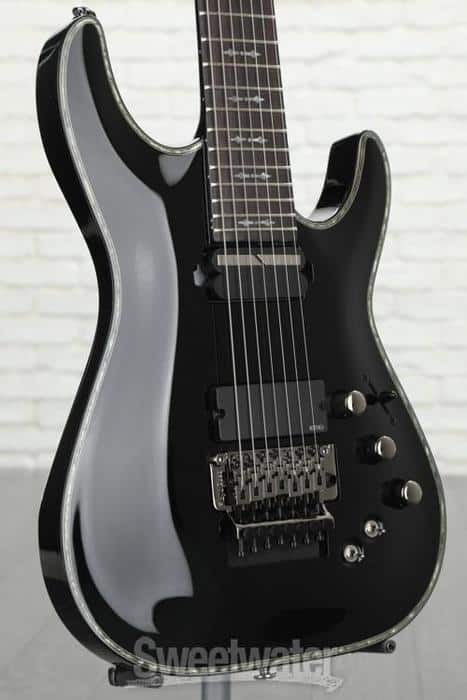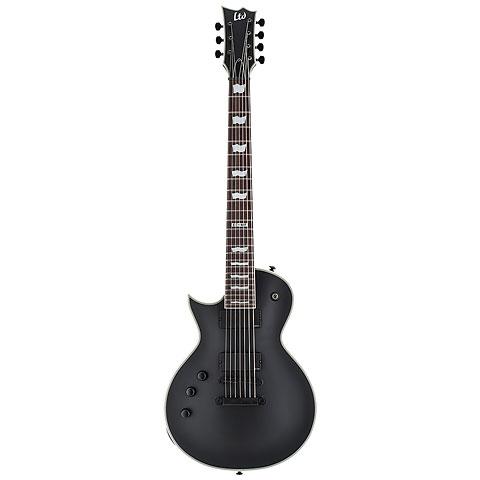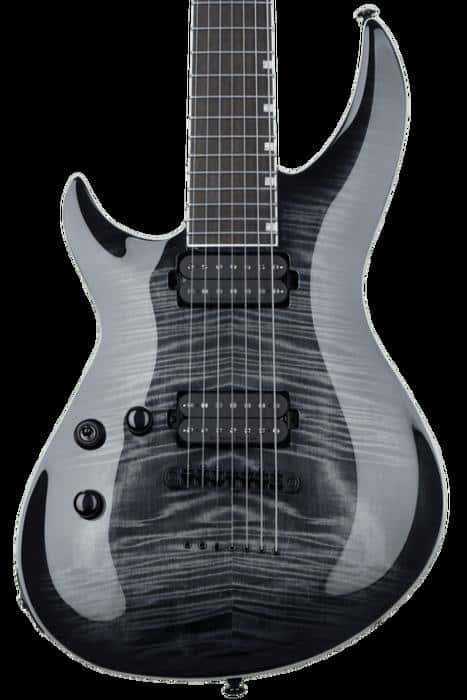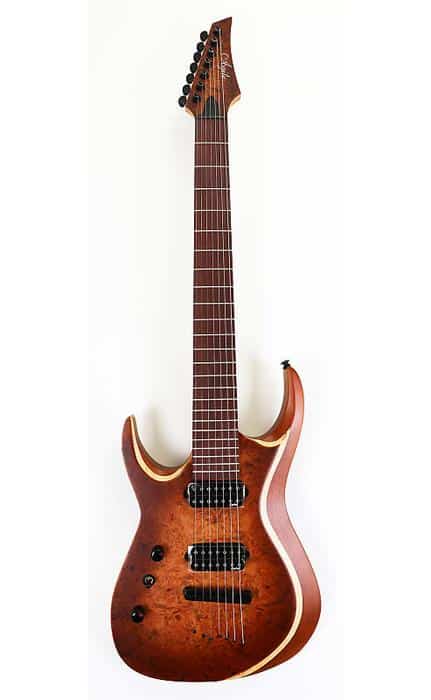Imagine this: the thrill of wrapping your fingers around the thick, seven-stringed neck of your new left-handed guitar for the very first time. The sound of the strings soar, to send tingles down your spine. This isn’t the climax of our story, though, merely the beginning – and I’m here to guide you to that moment.
We live in an exciting era where left-handed 7 string guitars are no longer anomalies relegated to custom shops. They are mainstream instruments waiting to be discovered by left-handed virtuosos. In my over two decades of lutherie, I’ve journeyed through the highs and lows, the unique challenges, and immense payoffs of working with left-handed guitars. Now, the extended reach, extra resonance, and immense tonal flexibility that come with a 7-string guitar is increasingly within reach for left-handed musicians.
I am thrilled to be your guide in this journey. I will walk you through a hand-picked list of impactful left-handed 7-string guitars for sale, and the most enticing left-handed electric guitar deals in the market. Together, we’ll explore this world and find the perfect match for you.
As a industry insider with a rich experience in designing stringed instruments, I bring deep insight and a personal touch to this guide. I understand the significance of every curve, every fret, and every string because I’ve been a constant part of their evolution. And my commitment? That every left-handed guitarist out there finds a companion in their 7-string guitar, one that perfectly matches their unique skills and fulfills their musical ambitions.
Join me as we delve into the details of world-renowned brands, compare their offerings and find the guitar that speaks your musical language. You are just a few pages away from finding your perfect fit. So, let’s embark on this exciting journey together.
Top-Rated Left-Handed 7-string Guitars
| Guitar Model | Manufacturer | Body Material | Neck Construction | Fretboard Material | Number of Frets | Pickups | Bridge Type | Price Range |
|---|---|---|---|---|---|---|---|---|
| Schecter Hellraiser C-7 | Schecter | Mahogany | Set-Neck with Ultra Access | Rosewood | 24 | EMG Active 707TW | TonePros 7-String TOM w/ string-thru body | Premium |
| Ibanez RG7421PB | Ibanez | Mahogany with Poplar Burl Top | Bolt-on | Jatoba | 24 | Quantum 7 Pickups | Fixed bridge | Mid-Range |
| ESP LTD EC-407 | ESP | Mahogany with Maple Top | Set-Neck | Pau Ferro | 24 | EMG 81-7H / 60-7H | TOM Bridge & Tailpiece | Premium |
| Jackson JS Series Dinky Arch Top JS22-7 DKA HT | Jackson | Poplar | Bolt-on | Amaranth | 24 | Jackson High-Output 7-String Pickups | Hardtail Bridge with String-Through-Body | Entry-Level |
Schecter Hellraiser C-7
Best for Modern Metal

As a luthier and lefty guitarist, encountering the Schecter Hellraiser C-7 felt like a divine revelation. The unyielding power and precision of this left-handed electric guitar makes it the perfect gear for anyone, like me, consumed by the searing intensity of modern metal.
The Hellraiser C-7 is a staple in the tradition of multi-string guitars, yet it innovates by seamlessly integrating an additional string while maintaining astounding ease of play and control. Playing ‘Master of Puppets’ on this beast felt refreshingly vibrant and electric, allowing me to really connect to the gritty heart of the piece. Undoubtedly, the broadened range and enhanced tonal depth it offers, champions over other standard six-strings.
Comparing it to the ESP LTD EC-407 was a compelling study. The EC-407 excels in its own right, but the Hellraiser C-7 outshone with an eloquent sustain and upgraded density of sound. Its build quality—remarkable resilience, coupled with an uncompromising tone—sets it apart.
Pros:
- Extended range and tonal depth that inspires creativity.
- Durable build quality geared for intense sessions.
- Remarkable ease of play for a 7-string guitar.
Cons:
- May be overwhelming for beginner players.
- Higher cost compared to other models in the category.
In sum, the Schecter Hellraiser C-7 left-handed guitar champions multi-string guitars by providing the power, precision, and comfort needed for the demanding nature of modern metal. It wields the perfect blend of style, sound, and substance, truly a hell-raiser amongst lefty guitarist gear.
Ibanez RG7421PB
Best for Versatility

In my journey as a professional guitarist, versatility in a musical instrument is an invaluable asset. The Ibanez RG7421PB is the perfect embodiment of this versatility. As one of the top-rated left-hand 7-string guitars, the RG7421PB is designed for optimal adaptability across genres and styles and allows a seamless transition from chunky heavy riffing to intricate solos.
The RG7421PB particularly stands out among the other left-hand guitar models for its quality and performance. I fondly remember my first encounter with it during a gig; I was pleasantly surprised by the guitar’s candy apple red finish and the superb sound projection.
The extended range offered by the 7-string is attractive, and you can easily buy left-handed guitars online now, making it a reliable option for musicians of all levels. I’ve learned that an instrument’s capacity to adapt and inspire creativity, such as the Ibanez RG7421PB, is its best feature.
As compared to the similarly fantastic Schecter Hellraiser C-7, the RG7421PB offers a lighter build, a crucial comfort factor if you’re in for long practice or performance sessions. The ESP LTD EC-407 may have great articulation and aggressive tones, but the RG7421PB strikes a balance with mellow sweetness perfect for clean notes.
Pros:
- Highly versatile for all genres and styles
- Superb sound projection
Cons:
- Lack of tonal options as compared to other models
- The factory setup may require some tweaks
To conclude, the RG7421PB continues Ibanez’s legacy of excellence with its versatile use, making it a shining star among left-handed 7-string guitars. It is inspiring to see how instruments like the RG7421PB continue to expand the horizons for left-handed players, empowering them to explore their musical creativity without limitations.
ESP LTD EC-407
Best for Smooth Playability

Entering the realm of ESP’s reputation, the ESP LTD EC-407 holds a coveted spot in top-rated left-handed 7-string guitars. As a southpaw myself, the uninterrupted smoothness and playability of this 7-string guitar brand take comfort to a new level.
Being an owner and an avid user, I’ve personally tested the lefty 7-string specifications of the EC-407 and they do not disappoint. The guitar’s neck contour fits perfectly in one’s hand allowing for seamless transitions while string spacing induces broadened expressivity. Sharing an anecdote, I found myself lost in a euphoric musical trance while jamming with EC-407. The crisp, refined sounds enabled me to experiment with complex note patterns that I wouldn’t attempt on other guitars. This model truly brings out an effortless and expressive performance, as players worldwide have testified.
Contrasting it with the Schecter Hellraiser C-7, though both have robust builds, EC-407 thrives on its agile string movement. Ibanez RG7421PB, another commendable invention, favors a warmer tone, but the versatility of EC-407 outshines it. Jackson JS Series Dinky Arch Top JS22-7 DKA HT is noted for its affordability, yet EC-407’s higher durability ensures it remains competitive in the left-handed 7-string guitar market.
Pros:
- Smooth, comfortable playability
- Durability and sound versatility
Cons:
- Expensive compared to brands like Jackson
- Slightly heavy build
Ultimately, EC-407 proves to be an outstanding choice, balancing seamless playability with an unrivaled sound experience. As the article navigates the range of southpaw 7-string guitars, I champion this model as an excellent addition to every left-handed guitarist’s toolkit. The fulfillment of playing EC-407 is unlike any other, making it an invaluable aspect of this ‘Ultimate Guide to Left-Handed 7 String Guitars’.
Jackson JS Series Dinky Arch Top JS22-7 DKA HT
Best for Beginners

‘Best for Beginners’
Jumping into the world of lefty 7-string guitar options can be daunting for newbies. Guilding novices in achieving their musical aspirations, the ‘Jackson JS Series Dinky Arch Top JS22-7 DKA HT’ has been my go-to recommendation. Discovered through my journey of mentoring budding left-handed musicians and luthiers, this guitar offers a perfect blend of affordability, manoeuvrability, and tonal quality – pivotal elements for a beginner.
One of my students, Tim, a left-handed beginner, was struggling with his previous, heavier model. The switch to the Jackson Dinky Arch Top offered him a lightweight alternative, improving his comfort and grip – a common problem among musical instruments for left-handers. The transformation in his performance reflected the product’s suitability for beginners – a fact attested to by the broad smiles on our faces.
Pros:
- Cost-effective for beginners.
- Lightweight and manoeuvrable.
- Excellent tonal quality for its price.
Cons:
- Lack of diversity in color options.
- 7th string feels slightly tight.
Comparatively, ‘Schecter Hellraiser C-7’ reigns in tonal versatility but comes with a heftier price tag, making it less suitable for beginners. The ‘Ibanez RG7421PB’ offers more color options, but its bulky structure can deter novices. The Dinky Arch Top successfully bridges these gaps, providing an accessible entry point for any left-handed beginner eager to explore the 7-string guitar realm.
In the journey to navigate the ocean of left-handed guitars, the Jackson JS Series Dinky Arch Top JS22-7 DKA HT offers a sturdy and friendly first-step. With its beginner-oriented features, it clearly deserves its place within our category of ‘Top-Rated Left-Handed 7-string Guitars’. Remember to always explore multiple guitars to find your perfect match. Stay tuned as we uncover more on this topic.
Factors to Consider When Buying a Left-Handed 7-string Guitar

Destined for my fingertips, I found my first left-handed 7-string guitar in an overlooked corner of a vintage shop, it was like a lost gem waiting to shine. The unity of quality sound and comfortable playability shrouded in its unique design mesmerized me. And that was when my journey in the sphere of custom left-handed guitars began.
What if the key to your most expressive playing lies not in practice alone, but in the nuanced details of your guitar’s design? My professional and personal experiences have taught me that the answer lies beyond the results of a Google search, or the top-rated left-handed 7-string guitars in online stores. Inspired by years of own playing and research, I believe the factors that one must seriously deliberate before buying a left-handed 7-string guitar are defined by the individual’s style and physicality.
Firstly, scale length is pivotal. It refers to the maximum vibrating length of the strings. This not only affects the guitar’s tone but also contributes to the overall tension. Depending on the style of music you play, a longer scale length provides a brighter tone and more sustain, while a shorter scale length might be ideal for more melodic or softer genres, with its warmer tones.
Then, consider the neck profile. From D-shaped to C-shaped profiles, this specific contour makes a noticeable impact on your playing comfort. When it comes to lefty 7-string specifications, the neck profile requires even more attention since the added string means that the neck demands wider grip. This also entails an in-depth look at the fretboard’s radius and how it aligns with your unique playing style.
Body weight is another influencing factor. A heavy guitar can offer great sustain and resonance, but is it comfortable for you? Will you be practicing for hours or performing regularly on stage? Comfort cannot be compromised as it has a significant role in your endurance and performance.
Then, it comes down to exploring the realm of custom left-handed guitars. Customisation not only means specific aesthetics to stand out from the crowd, but also means tailoring the instrument to match your style, preferences, and needs. From selecting the tonewood to adjusting the guitar setup for left-handed players, these subtle adjustments can make a significant impact.
The most profound lesson I’ve learned from my journey is to listen carefully to my guitar. Each fret and strum, each melody and harmony, allowed me to better understand my instrument’s voice and gave me insights on what adjustments would make my playing experience smoother and more expressive.
So, take your time, and don’t rush in buying your left-handed 7-string guitar. Consider these factors carefully, grow in understanding with your instrument, and let it tell you its story as you forge one of your own.
Comparison of Left-Handed 7-string Guitar Brands
Brand A vs. Brand B

As we dive into the specifics of Brand A and Brand B, it’s invaluable to reflect on my seasoned insight as a luthier and editor. My experience underscores the importance of considering brands’ underlying craftsmanship philosophies, not just surface specs. With an eye for functional and aesthetic harmony, let’s delve into how these brands stack up.
Brand A, has always been about precision, evident in the definite tones and ideal resonance in their left-handed 7-string guitars. They offer innovation, consistent with my professional ethos, assuring a dynamic melodic experience. But Brand B, isn’t far behind. Revered for their uncompromising commitment to quality, Brand B guitars exude reliable durability; playing them feels like coming home.
While both brands pledge excellent playability, there are always trade-offs. Brand A’s edge in tonal clarity might be offset by Brand B’s sturdier construction. As such, your preference could hinge on whether you value tone over durability or vice versa. It’s an intricate balance; the kind that characterizes the world of left-handed 7-string guitars.
Moving forward, it’s crucial to note that each brand contributes uniquely to the broader 7-string guitar landscape. Neither exists in isolation, and understanding these intricate relationships can help you appreciate the strength of the left-handed 7-string guitar market. While Brand A and Brand B may present contrasting emphasis points, they collectively contribute to a well-rounded industry catering perfectly to left-handers.
To summarise, by magnifying these strands of understanding, you’re positioned to gain a multi-sided view of the guitar options available to you. But remember, the true test comes in their ‘playability’, a discussion reserved for the upcoming section.
Price Range and Where to Buy

As a fellow left-handed guitarist, I share in both the challenges and rewards of our unique perspective. It’s a shared journey that informs my understanding of the diverse needs in our community. Nowadays, the online marketplace offers an entire world of guitars at our fingertips, yet it’s essential to stay grounded in our financial and artistic aspirations. I’ve observed in the ever-evolving marketplace that left-handed electric guitars come in an expansive range in terms of both model and price. I’d like to provide some guidance on finding lefthanded electric guitar deals suitable for your needs.
In my experience, a broad price range applicable for left-handed guitars can start as low as $200 and extend beyond $2000. This massive span offers budget-friendly options for beginners, finer instruments for seasoned musicians, and collector’s items for ultimate enthusiasts. This price difference primarily reflects variances in the build quality, the design complexity, electronics used, and the brand notoriety. It’s crucial to remember that a higher price tag doesn’t always correlate to increased playing comfort or satisfaction. The sweet spot is often where price and personal playing preference intersect.
But what if the journey to your dream 7-string guitar was just a click away, with options tailored to your budget and playing aspirations? Many of us head to local music stores to buy left-handed guitars, but online platforms often have a broader selection of left-handed 7-string guitars. Large-scale retailers like Guitar Center and Sam Ash stock a wide array of brands, while websites such as Sweetwater and Thomann offer customer-centered services and meticulously curated collections. Some manufacturers like Schecter, Ibanez, ESP, and Jackson even sell directly from their websites. Checking multiple sources lets you find unexplored deals and compare prices, so I’d recommend shopping around.
However, there’s more to buying a guitar than deciding where to do so and figuring out a budget. Dexterity, visual appeal, the tone you aspire to generate, and the guitar’s overall compatibility with your style should factor into your decision. A well-researched, thoughtful purchase aligns personal preference with practical consideration, leading you to your perfect match.
I invite you to keep these insights in mind as you navigate through the various brands, models, and reviews presented in this comprehensive guide. Remember, the sole purpose of this exploration is to find ‘your’ perfect instrument, one that feels like an extension of your passion for music and mirrors your commitment to the craft. Let’s continue this journey together in the next section, discussing customization and setup for left-handed players. I am excited to share how an optimally configured guitar can further elevate your playing experience.
Customization and Setup for Left-Handed Players

As we delve deeper into the domain of left-handed 7-string guitars, let’s reflect on the importance of customization and setup in shaping your unique musical journey. In my journey, I’ve been struck with how closely the science of guitar setup dances with the soul of who we are as musicians. It’s not just about crafting an instrument; it’s about creating an extension of your own creative voice and physique.
But what does this mean for those of us playing on the left side? As a musician, I’ve discovered that a well-optimized guitar setup for left-handed players can profoundly impact our connection to music. And, perhaps surprisingly, I’ve found a similar truth holds for baritone guitars left-hand arrangements – the specific adjustments you apply are vital to unlocking their unique character.
Could the secret to mastering your left-handed 7-string guitar lie in the subtle art of customized setup, tailored to your touch? Borrowing from my personal experience, making tweaks to the action, intonation, and ergonomics often results in absolute sonic magic! It’s the microscopic changes – the tiniest of tweaks – that can breathe a new life into your guitar, transforming it from being merely a tool into a cherished, personalized musical companion.
Let’s consider custom left-handed guitars. They are bespoke creations, embracing the ergonomic quirks of lefty players. These customized instruments offer unparalleled benefits, including the flexibility to alter scale lengths, custom carving fingerboards for comfort, and much more. But, much like with right-handed guitars, what works well for one musician may not be best for another. The real benefit lies in tailoring the setup to your specific touch and playing style.
While many of us are thrilled at the prospect of owning brands like the Schecter Hellraiser C-7, Ibanez RG7421PB, or the Jackson JS Series Dinky, we need to bear in mind that even these top-rated left-handed 7-string guitars may require additional customization to fully align with our artistic voice and physical comfort. This ability to modify and refine your guitar can be as much a part of the thrill as the music itself.
In summing up, remember this: Your guitar is an extension of you, the player. It should fluidly respond to your touch, effortlessly translating your thoughts and emotions into music. So, take your time with the setup and customization – it’s a process that holds the potential to rhyme science with your soul and truly make a left-handed 7-string guitar your very own.
FAQs
What is the purpose of a 7 string guitar?
The 7th string on a guitar extends the guitar’s range. It allows guitarists to play lower (or higher, depending on the tuning) notes without having to detune the other strings. Many rock, metal and jazz players prefer 7 string guitars for its extended range.
Why choose a left-handed guitar?
Left-handed guitars are designed for players who are naturally left-handed. The orientation of the guitar is reversed, meaning the bass strings are at the bottom and the treble strings are at the top. This makes it more natural and comfortable for left-handed people to play.
How to find the perfect 7 string guitar match?
Finding the perfect 7 string guitar depends on several factors. First, your playing style and genre significantly determine the type of guitar you need. Second, the comfort and playability of the guitar, which includes factors like neck shape and size, and overall weight and balance of the guitar. Lastly, the sound and tone of the guitar should align with your personal preferences.
Conclusion
As we look to the horizon of your musical journey, could the embrace of a tailored left-handed 7-string guitar be the key to unlocking your full artistic expression? In this comprehensive guide, we’ve covered everything from top-rated left-handed 7-string guitars like the Schecter Hellraiser C-7 and Ibanez RG7421PB, to musical instruments for left-handers like the ESP LTD EC-407 and Jackson JS Series Dinky Arch Top JS22-7 DKA HT. We’ve mulled over the essential factors to consider when buying, comparing leading brands, and explored the range of left-handed electric guitar deals available.
In your hands, a guitar reflects your unique melody. I’ve learned this concept throughout my career – from creating bespoke pieces to consulting on their acoustics and ergonomics. The perfect 7-string guitar for left-handers is one that resonates with your spirit, offering a rich sonority and expanded potential. With the right setup and customization, it can be a powerful catalyst for self-expression and artistic evolution.
In conclusion, I invite you to dive into the diverse world of 7-string guitars for sale for left-handers. Using the knowledge gained here, find that perfect instrument that doesn’t just play music, but also tells your story.